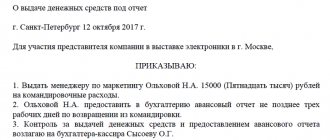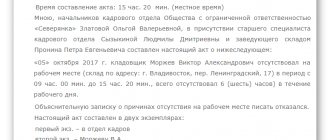Differences between the procedure for relocating an employee and transferring to another position
The transfer of a specialist involves a change in the labor functions he performs while continuing (without interruption) his work activity in the same place of employment (without changing the employer). The procedure, carried out by agreement of the participants in the labor process or on the initiative of the management of the enterprise, can be temporary or permanent. The temporary nature of the transfer is related to the period of absence of any specialist in the company or to the state of health of the worker himself.
Transfer to another job is possible with the written consent of the employee, except for some cases specified by law (Article 72 of the Labor Code of the Russian Federation). The transfer of a citizen to work for another employer is permitted at the employee’s written request (written consent) with the termination of the employment contract at the old place of employment (Article 77 of the Labor Code of the Russian Federation).
The movement of an employee is his movement within the organization, not accompanied by a change in job functions. The process is always carried out in the same area, and the essential terms of the employment agreement do not change.
The situation relates to internal issues resolved by the management of the enterprise and not requiring the consent of the employee (Articles 72, 73, 74 of the Labor Code of the Russian Federation). The employer must notify the specialist in advance about upcoming changes. He does not have the right to refuse to perform labor duties under changed conditions (in a new place, in a different structural unit).
Relocation, unlike permanent transfer of a worker, does not require registration in a work book. When transferring to an existing contract with an employee, an additional agreement is drawn up, which defines the essential conditions of the activity.
The transfer procedure may require the employee to have special skills; when moving an employee, there are no such requirements.
Important! Any movement must be justified for production reasons. Without them, movement in a number of situations may be considered illegal, especially if there are personal motives of the organization’s management.
Order on delegation of powers
In some cases, the possibility of delegating the responsibilities of a manager may be stated in the employment contract with him or in the constituent documents of the organization. Since the list of rights and responsibilities of a manager is voluminous, and his decisions have significant consequences for the company’s activities, the transfer of powers of the manager must be carefully thought out and formalized properly. There are two most common options for transferring the authority of a manager to his subordinates. In the first option, the management of the company is transferred to a full-time deputy.
In the second, the manager’s powers are transferred to one of the organization’s employees.
The first option is much simpler. The manager issues an order that his functions are transferred to the deputy for a certain period. Managing a company in the absence of a manager is one of the job functions of his deputy, therefore, in this case, concluding a special agreement on the delegation of powers is not required.
Types of employee movement
The procedure provides several options for moving:
- To another workplace. The employee continues to perform his job duties without changes, but in another office or in another building of the organization.
- To another division of the company. Such structural units (management, branch, sector) cannot always be located at a single address, but must always be located within the same locality (city, town, village). In such cases, the procedure will be considered precisely the movement of the employee.
- To perform work on other equipment (unit, mechanism). For example, the driver continues to perform the previous functions of transporting (goods, passengers) in a new vehicle assigned to him. In this option, changing the tool of work should not contradict the employee’s responsibilities as defined by the employment agreement or job description.
Important! An employment contract may contain an indication of the workplace (unit) for the employee’s work. If the specified conditions change, the procedure is recognized as a transfer and not a rearrangement.
Conditions for movement
The company's management can rearrange (relocate) employees during the work process without changing job responsibilities, working conditions, or area of employment for reasons depending on the production interests of the enterprise and carried out without taking into account the interests of specialists.
Reasons for the procedure may be:
- production necessity, which results in adjustments to the company’s staffing schedule;
- reduction or expansion of the enterprise’s production activities;
- situations of professional and career growth of personnel.
In such situations, the moving employee must follow the orders of the employer or his representatives performing administrative functions at the enterprise.
Important! An employee cannot be transferred to another place of work that is contraindicated for him for reasons related to health. But if the employer did not receive notification of the presence of contraindications, and the employee himself hid such information, then in the future this circumstance may be regarded as an abuse of his right by the worker.
Procedure for registering employee relocation
The management of the enterprise has the right to move an employee to another structural unit for production or other reasons, including medical indications. In this case, the conditions for the location of the new place of work in the previous area and the absence of significant changes in the labor function (job responsibilities) must be met:
- To reshuffle a specialist, the head of the enterprise issues an appropriate order, which defines a new job or structural unit for the employee to perform job duties.
- The basis for preparing the order is a report (official) note drawn up by the head of the department or structural unit where the specialist works.
- The document is submitted for consideration to the management of the organization, who affixes a conciliatory resolution, the corresponding date and signature.
If the initiative to move to a new place of work comes from an employee, the latter draws up a written application. The text of the document must contain a request to move the applicant to another unit or to another position, indicating the reasons that necessitated such a procedure. The application must be accompanied by supporting documents or medical reports if there are medical indications for moving the worker.
The application is brought to the attention of the management of the enterprise, which, if agreed, issues an authorization visa, which serves as the basis for preparing the appropriate order for the organization.
The text of the order states:
- position held and name of the department or unit where the applicant works;
- grounds for reshuffle;
- name of the unit or position (according to the staffing table) to which the specialist is transferred.
The specialist must familiarize himself with the prepared order and submit his visa for familiarization.
Important! An additional agreement is not drawn up to the employment agreement with the employee, since there is no change in his main job function. An entry about the employee’s movement is not made in the work book (Article 72 of the Labor Code of the Russian Federation).
We transfer cases
The handover process involves not only a report on the status of work, but also verbal recommendations on how to perform job responsibilities. The order is created to convey the boundaries of responsibility and job responsibilities as accurately as possible. It is compiled by the head of the company in any form.
Information contained in the order:
- Information about the organization.
- Number and date of compilation.
- Full name and position of the receiving and transferring parties.
- The reason and timing of the acceptance and transfer.
- List of cases that will be transferred.
- Composition of the commission and information about its chairman.
- Effective date.
- Additional instructions: conduct an inventory, audit, etc.
- The person responsible for the procedure.
- order on the acceptance and transfer of cases in connection with dismissal
- order on the acceptance and transfer of cases in connection with dismissal
The order to accept cases in connection with dismissal is signed by the general director. The persons mentioned in the order must also sign.
This is important to know: What documents are needed for the exchange after dismissal
Legal consequences of moving or refusing it
The management of the organization has the right to make any personnel changes aimed at increasing the rational use of property and the efficiency of the enterprise. Each specialist is obliged to comply with the employer’s decision to relocate him.
Refusal to execute a transfer order is equivalent to a disciplinary violation on the part of the worker (Article 192 of the Labor Code of the Russian Federation).
ATTENTION! In case of substitution of concepts and registration under the guise of transfer without the knowledge and consent of the employee of his actual transfer (with a change in working conditions), the management of the organization may face punishment.
If an employee refuses to perform official duties during his illegal reshuffle, in accordance with the law, his labor rights remain unchanged (Article 81, 379 of the Labor Code of the Russian Federation). In this case, the employee cannot be subject to disciplinary liability. The employer also cannot prevent the employee from protecting his own labor rights (Article 380 of the Labor Code of the Russian Federation).
If the transfer is declared illegal by the court, an employee may file a claim for payment of the difference in earnings (for the period of performing other work), for payment for forced absence time, for compensation for moral damage caused to him (Article 236 of the Labor Code of the Russian Federation).
Order on transfer of functionality to other employees
The transfer must be carried out with all property and staff. Employees do not object to the transition, their working conditions do not change. What is the mechanism for such a transfer from the point of view of labor relations? Having considered the issue, we came to the following conclusion: Employees, with their consent, can be dismissed and hired by another employer by way of transfer.
In the absence of consent, employees may be dismissed due to staff reduction and accepted into another institution in accordance with the general procedure. Important How to delegate the authority of a manager? There are two most common options for transferring the authority of a manager to his subordinates. In the first option, the management of the company is transferred to a full-time deputy.
In the second, the manager’s powers are transferred to one of the organization’s employees. The first option is much simpler.
The manager issues an order that his functions are transferred to the deputy for a certain period.
Answer
When laying off workers, their positions are excluded from the staffing table the day after dismissal.
Until the day of dismissal, employees continue to perform work in accordance with the employment contract and the labor function defined by it. In this regard, the transfer of functions from one division to another until the dismissal of employees is impractical.
It turns out that the work will be carried out simultaneously by two departments.
In this regard, the transfer of functions from one division to another should be formalized the day after the dismissal of employees.
Details in the materials of the Personnel System:
Situation: How to formalize dismissal when reducing numbers or staff
Ivan Shklovets
, Deputy Head of the Federal Service for Labor and Employment
The difference between staff reduction and headcount reduction
You can dismiss an employee if you reduce his position or the number of employees (clause 2, part 1, article 81 of the Labor Code of the Russian Federation). Staff reduction means that the position itself is being reduced. A reduction in numbers means that the number of units for the same position is reduced. In this case, the position is retained, only fewer employees work in it.
If you dismiss an employee due to a reduction in headcount or staff, it is important to follow the procedure established by law (Articles 179 and 180 of the Labor Code of the Russian Federation). It is impossible to deviate from it, otherwise the employee will have grounds to be reinstated at work and receive payment for the time of forced absence (Article 394 of the Labor Code of the Russian Federation).
Carry out the downsizing procedure in the organization in the following order:
- issue an order to reduce the number or staff and prepare a new staffing table;
- determine whether any employee has a preferential right to be retained;
- create a list of employees (positions) you are cutting;
- notify employees of the upcoming dismissal (part 2 of article 180, part 2 of article 292, part 2 of article 296 of the Labor Code of the Russian Federation);
- offer those you are laying off other vacant positions (part 3 of article 81, part 1 of article 180 of the Labor Code of the Russian Federation);
- formalize the transfer of those employees who agreed to fill vacant positions (Article 72.1 of the Labor Code of the Russian Federation);
- notify the trade union (if there is one in the organization) about the upcoming layoff and report the layoff to the employment service (part 1 of article 82 of the Labor Code of the Russian Federation, clause 2 of article 25 of the Law of April 19, 1991 No. 1032-1);
- agree with the trade union (if there is one in the organization) on the fact that you are dismissing employees who are members of the trade union (Part 2 of Article 82 of the Labor Code of the Russian Federation);
- dismiss due to a reduction in the number or staff of employees who, among other things, did not agree to fill vacant positions (clause 2, part 1, article 81 of the Labor Code of the Russian Federation);
- pay everyone laid off severance pay and compensation (Article 178, Part 3, Article 180 of the Labor Code of the Russian Federation).
With respect and wishes for comfortable work, Tatyana Kozlova,
We combine departments: how to register
Often, in order to increase the efficiency of a company, its management unites different departments.
There are two ways to consolidate departments:
- combine two departments and create a new one on their basis, for example, combine the transport and economic departments into transport and economic departments;
- attach one department to another, for example, the transport department to the economic department. In this case, a new department is not created: the economic department is retained, but its competence is expanded by incorporating the transport department into it.
Moreover, the goal that is usually pursued during such a reorganization is not the reduction of some personnel, but the improvement of interaction between employees of the merged departments. It is for this purpose that two previously independent structural divisions are united under a single centralized leadership of the head of the enlarged department.
With such a merger of departments, their employees, as a rule, continue to perform their previous duties in the enlarged unit. Therefore, questions arise: is it enough to formalize the consolidation of departments by making changes to the staffing table, or is it impossible to do without filing a whole bunch of personnel papers?
To answer them, let's consider the features of each of the two options for consolidating departments.
OPTION 1. Create a new department from two old ones
STEP 1. Change the staffing table . To do this, we issue an order on structural reorganization, which:
- we approve the company’s new staffing table in its entirety (it must be attached to the order);
- We are making changes to the current staffing table.
WE WARN THE MANAGER
In fact, the enlarged department will start working no earlier than 2 months after the issuance of an order to amend the staffing table. After all, employees for whom something changes must be notified about this no later than 2 months in advance.
The second method is less cumbersome, since in this case only the text of the changes themselves is attached to the order, and not the entire “staff” of the company.
Also, changes in the staffing table can be stated in the text of the order itself, and not in a separate appendix to it.
Please take into account an important nuance: changes in the company’s organizational structure can be put into effect no earlier than 2 months after the publication of the mentioned order. If only because when departments are enlarged, some employees may have to be transferred to other jobs or laid off. These include heads of departments, because in the new department there will be no positions of head of the transport department and head of the economic department, but there will be a new position of head of the transport and economic department. Also, if each of the previous departments had secretarial positions, the employer can reduce one secretarial position and leave only one secretary in the new enlarged department.
And even if such workers are eventually transferred to another job, they will still have to start the process of reducing their current positions. And if so, they will have to be notified in writing 2 months in advance about the reduction and Art. 180 Labor Code of the Russian Federation. The same opinion is shared by Rostrud.
From authoritative sources
“ When merging departments, employees holding positions as heads of these departments should be notified of the reduction of their positions 2 months in advance. The basis for carrying out reduction measures is the employer’s order to make changes to the organization’s staffing table (or to approve a new staffing table).”
An order to amend the staffing table can be issued as follows.
Limited Liability Company "Zeta"
ORDER No. 12
About changes to the staffing table
In order to improve the organizational structure of Zeta LLC, combine the transport and economic departments into the transport and economic department, in connection with which:
1. Remove from the organization’s staffing table: - transport department; - maintenance department.
2. Reduce the following positions: - head of the transport department; - head of the economic department.
3. Introduce the transport and economic department into the staffing table of the organization (the staffing list of the transport and economic department is attached).
4. Put into effect the changes provided for in paragraphs 3 of this order from 05/05/2011.
5. Entrust control over the execution of the order to the chief accountant of the organization L.V. Sinitsina.
Simultaneously with making changes to the staffing table, it is advisable to develop and approve regulations for the new department. After all, the employees of this department need to know in advance about the structure, main tasks, functions of the new department, as well as the procedure for its interaction with other structural divisions. Employees of the department must be familiarized with the new position under the signature of Art. 22 Labor Code of the Russian Federation.
STEP 2. We deal with the employees for whom the layoff procedure is being launched and who will have to either be transferred to another job or fired due to layoffs. All such employees must be given a notice of layoff and Art. 2 months before the layoff against signature. 180 Labor Code of the Russian Federation.
ATTENTION
Do not forget to notify the trade union (if there is one) and the territorial employment authority 2 months in advance about the upcoming layoff. 82 Labor Code of the Russian Federation; clause 2 art. 25 of the Law of the Russian Federation of April 19, 1991 “On employment in the Russian Federation”.
The notice must include a proposal for transfer to another vacant position if there is a vacancy that can be offered to the employee at Art. 81 Labor Code of the Russian Federation, Art. 180 Labor Code of the Russian Federation. For example, we offer translation to the heads of both departments. One of them - to the position of head in a new department, and the second - to some other position (perhaps even in another division of the company).
After all, it is possible to dismiss an employee due to reduction only on the condition that it is impossible to transfer him with his consent to the same organization and Art. 81 Labor Code of the Russian Federation:
- for a vacant position or a job that corresponds to the employee’s qualifications (including for a higher position, if he has the required qualifications);
- for a vacant lower position (lower paid job), which he can perform taking into account his qualifications and health status.
For more information on how to properly carry out a reduction, see: 2009, No. 1, p. 51
And if you are cutting two overlapping positions and the company has only one vacancy to which both employees can be offered a transfer, then you need to check whether one of them has a preferential right to remain at work. 179 Labor Code of the Russian Federation. This advantage is given to the employee who has higher labor productivity and qualifications. 179 Labor Code of the Russian Federation. When comparing labor productivity, in particular, data on the completion of assigned tasks, the presence of disciplinary sanctions, etc. are taken into account. And qualifications are confirmed:
- whether the employee has professional education;
- the level of his theoretical knowledge and practical skills, the degree of mastery of which can be expressed in the class, category, etc. established for the employee.
If the compared workers have equal labor productivity and qualifications, then preference is given to remaining at work, in particular Art. 179 Labor Code of the Russian Federation:
- family - if they have two or more dependents (that is, disabled family members (spouse, parents, children, Article 2 of the Family Code of the Russian Federation) who are fully supported by the employee or receive assistance from him, which is the main thing for them and a permanent source of livelihood);
- not having other independent workers in the family;
- who received a work injury or occupational disease while working for this employer;
- improving their qualifications in the direction of the employer without interrupting work.
Notice of layoffs can be formatted as follows.
Limited Liability Company "Zeta"
To the head of transport Talalaikin A.S.
Instructions for drawing up a document
The order is drawn up in the generally accepted form, but there are some differences from other documents for the enterprise .
Form
The legislation has not developed a special form for such a document, which means freestyle. Like any other, such an order is printed with the company details and address at the top of the sheet.
Expert opinion
Lebedev Sergey Fedorovich
Practitioner lawyer with 7 years of experience. Specialization: civil law. Extensive experience in defense in court.
Below in the center is the name - the order, on the next line on the left indicate the point where the change of chief accountant takes place and the company is located, and on the right - the date.
On the left, a short column describes the topic of the document, in this case it looks like this: “Concerns the transfer of affairs by the chief accountant.” Below, with a paragraph, the text part of the document begins.
Contents of the paper
The first point is that the head of the company, on whose behalf and signature the order will be issued, must state the reason for the transfer of financial papers , for example: “In connection with the dismissal of the chief accountant, I order:”, and then place the points one after another. When obliging to provide folders, papers, and information on a computer, it is imperative to set a deadline during which the orders must be completed.
This is important to know: Retrenchment of a disabled person of group 2 due to staff reduction
The period for which the documentation is transferred should also be specified (usually 3 years).
If the chief accountant tries to hide information, does not disclose all the nuances of the actual situation of finances or taxes, the availability of materials, etc., or openly ignores this document, then it turns out that the order is not being executed, and it is possible that the employee who has access to the company’s finances , intends to hide the abuse.
In this case, completely different disciplinary measures may be taken, taken into account by the Labor Code of the Russian Federation, and the cases will be entrusted to a commission, the competence of which will make it possible to clarify the situation and identify shortages of funds or materials.
The order must specifically indicate the full name and position of the person submitting the case, as well as the details of his successor. The person accepting the papers may be the new chief accountant, and if the candidacy has not yet been approved, then there is an option to entrust the acceptance of the documentation to a deputy or other official.
Other persons may also be involved in the transfer of cases - the financial director, a representative of the company's own security service, etc. During the period allocated for acceptance from the outgoing chief accountant, an inventory of the material base is usually also carried out.
The date of issue of the order must correspond to the one that coincides with the registration log, and at the same time precede the acceptance process by 1-2 days: the persons involved in this action must be familiar with the document for signature.
The document also stipulates the powers and responsibilities of those who participate in the delivery and acceptance of cases from the chief accountant. For example, you can indicate that if any shortages or discrepancies are identified, an audit firm should be involved. Based on the results of acceptance, an act must be drawn up, specifically specifying what the order should specify in the order and indicating the person responsible for this.
The manager usually retains control over the execution of this document. Under the text, indicate the full position of the manager and his full name, and after signing, list the positions and full names of everyone who should be familiar with the document.
Everyone who is in one way or another involved in the transfer of cases and is mentioned in the order should be familiarized with its contents under the signature on the first copy. It is this order that is drawn up in 1 copy, which is necessary for office work, and for everyone mentioned, the secretary will prepare copies.
Expert opinion
Lebedev Sergey Fedorovich
Practitioner lawyer with 7 years of experience. Specialization: civil law. Extensive experience in defense in court.
The chief accountant has no right to leave without transferring the case, and to control this process an order must be issued for the enterprise. This is a simple document for the internal circulation of the company, but when drawing up the paper you need to know what exactly such a document should contain.
Didn't find the answer to your question? Find out how to solve exactly your problem - call right now:
How to outsource functions
Outsourcing traditionally refers to the transfer by one organization of certain business processes or production functions to another organization that specializes in the relevant field. That is, in essence, one company provides certain services to another on the basis of an ordinary civil law contract.
The transferred functions are generally non-core for the organization. For example, for a manufacturing company this could include legal services, marketing research, call center services, cleaning buildings, preparing and delivering lunches to the office, providing transportation services, maintaining the operation of a computer network and information infrastructure, providing advertising services, providing security, search, selection and training of personnel, etc.
What you need to consider when drawing up an outsourcing agreement
When concluding an outsourcing agreement, the following must be taken into account:
- outsourcing is not associated with the physical movement of personnel from the contractor’s company to the customer’s company, so the actual place of work of the employees remains the same;
- The tasks for the employees are set by the performer. The customer does not have any powers to manage personnel, since they are not under his control and jurisdiction;
- The amount of work that is outsourced is determined by the customer. Therefore, full-time employees of the customer organization can also perform similar functions.
- The customer can only evaluate the result of the service itself, but not the process of the contractor’s employees. For example, a clean office, properly prepared reports, etc.;
- The performer, that is, a legal entity, is responsible for the final result, and not the performer’s employees who directly provided the service. If necessary, the customer can make claims to the performing organization.
Thus, an outsourcing agreement is a regular civil contract between two organizations for the provision of services or performance of work, which in general are non-core for the customer organization. All activities within the framework of such an agreement are regulated by the norms of the Civil Code of the Russian Federation, and such agreements can be concluded without restrictions.
Case Study
The legal department in the company consisted of three employees; there was no division of powers between employees. Each lawyer dealt with all issues: drew up local acts, drew up contracts, wrote claims, went to court. Initially, there was little judicial work, and lawyers handled it on their own.
Over time, the company acquired many counterparties, contracts began to be concluded more often, and the volume of judicial work increased. Lawyers no longer managed to complete their work on time, because of the rush they made inaccuracies in contracts, and did not have time to properly prepare for trials. As a result, the cases were lost, the counterparties did not return the money.
The director of the company understood that the reason was the excessive workload on the legal department. He was faced with a choice: hire more lawyers or outsource the functions of conducting judicial work. He chose the second option, found a company that would prepare claims, materials, reviews and represent his interests in the courts. As a result, the director instructed his subordinates to develop and conclude an agreement on the outsourcing of judicial work.
Now he had to change the job responsibilities of lawyers and reduce their salaries.
Order on transfer of duties
The amount of additional payment is established by agreement of the parties to the employment contract and depends on the content and volume of additional work ().
d.; The performer, that is, a legal entity, is responsible for the final result, and not the performer’s employees who directly provided the service.
Despite the fact that combining professions or positions is not free for an employee, in order to assign additional responsibilities to him, written consent must be obtained from him. The parties must first agree not only on the content and scope of the delegated powers, but also on the period during which the employee will perform additional work.
It must be borne in mind that the employee has the right to refuse to perform additional work ahead of schedule, and the employer has the right to cancel the order to complete it ahead of schedule.
To do this, it is enough to notify the other party in writing no later than three working days (). When signing an additional agreement to the employment contract, which provides for the assignment of additional responsibilities to the employee, it is necessary to familiarize the employee with the job description of the employee being replaced.











